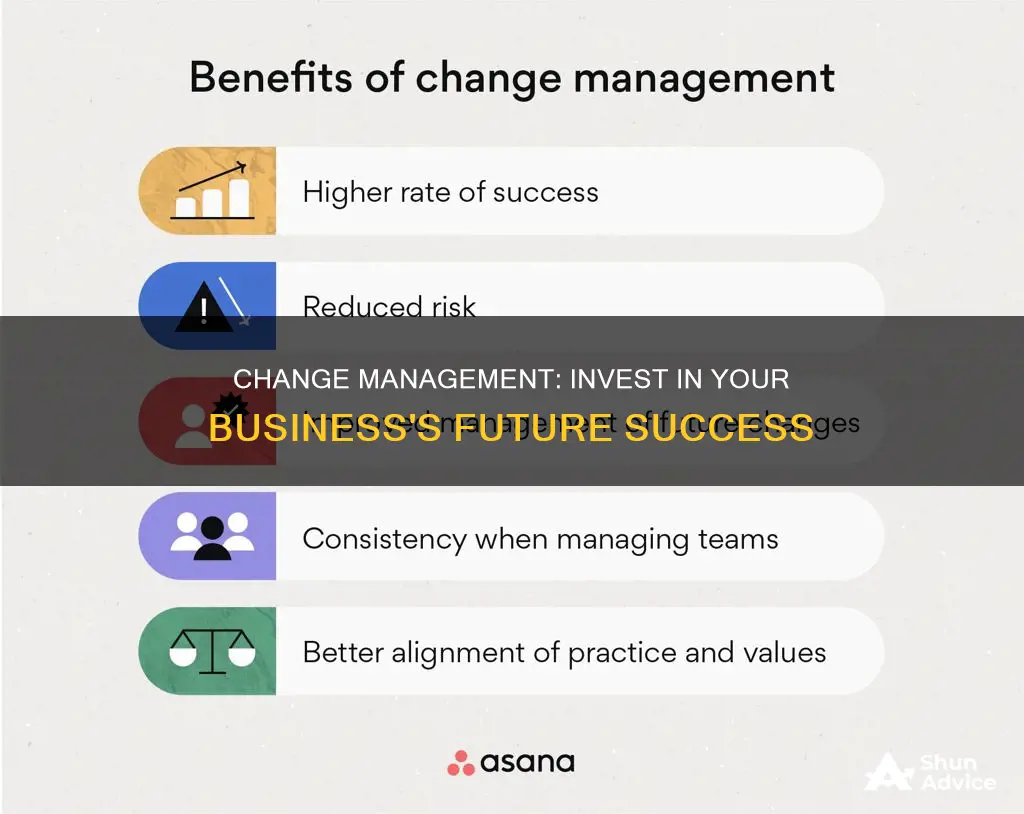
Change management is an essential aspect of any organisation, as it enables companies to deliver results, build competencies and capacity, and adapt to new situations. The business landscape is rapidly evolving, and change is occurring at an increasingly fast pace. Companies that fail to implement effective change management strategies may find themselves in organisational chaos, struggling to keep up with the competition.
Effective change management can help organisations navigate new operational and cultural territories seamlessly. It can also assist in driving successful change, handling the amount of change occurring, and preparing the organisation for the future. Additionally, it can create consistency and efficiency in approach, and build needed internal capabilities.
Furthermore, change management plays a crucial role in helping employees understand, commit to, and embrace new technology and initiatives. It can also facilitate effective communication between management and employees, ensuring everyone is on board with the changes.
Overall, investing in change management is crucial for the success and adaptability of any organisation in today's dynamic business environment.
What You'll Learn

To increase the chances of a project's success
Investing in change management is crucial for increasing the chances of a project's success. It is important to note that successful change is dependent on people. Change management focuses on enabling individuals to adapt to new ways of working, which is essential for achieving the desired results.
Change management ensures that employees embrace and understand new initiatives, technologies, or processes. Without effective change management, organisations may face resistance, confusion, and fear among their employees, hindering the success of the project.
A well-thought-out change management strategy helps organisations navigate new operational and cultural territories seamlessly. It aids in aligning the company's assets with the project's goals, facilitating greater economic value and faster implementation.
Additionally, change management plays a vital role in effective communication with employees. It ensures that employees understand the reasons for the change, how it will affect them, and what is expected of them. This open and honest communication fosters employee engagement and happiness, ultimately saving the organisation time and resources.
Furthermore, change management helps to create a more adaptable and innovative workplace. By setting a standard of effective change management and openness to change, organisations empower their employees to embrace new challenges and adapt to the inevitable changes that occur over time.
The benefits of change management are evident in increased project success rates. Studies have shown that excellent change management can increase the likelihood of achieving desired outcomes by up to six times. It also significantly impacts the project's budget and schedule, with higher success rates for on-time and on-budget deliveries.
In conclusion, investing in change management is crucial for increasing the chances of project success. It ensures employee engagement, effective communication, and adaptability, ultimately leading to greater project success and a more resilient organisation.
Investment Management SA: Strategies for Success
You may want to see also

To adapt to new situations and remain competitive
Change is inevitable in the business world, and it is happening faster and more frequently than ever before. Companies that don't adapt will fall behind and struggle to remain competitive. This is where change management comes in—it is a collection of processes that help organisations navigate short- and long-term transitions.
Change management is essential for businesses to adapt to new situations and stay competitive. It helps organisations implement new initiatives and strategies to boost their competitive advantage, increase profits, and improve productivity and performance. For example, a company might need to change its business model to keep up with evolving customer needs and expectations. With effective change management, this transition can be seamless, ensuring employees understand and embrace the changes.
Moreover, change management is crucial when adopting new technology. Employees often fear that new technology will make their roles redundant, so change management helps them understand and take ownership of the transition, creating a more open-minded workplace. It also ensures that employees fully embrace and understand new software, ensuring the investment pays off.
Change management also plays a vital role in communication. It helps organisations communicate openly, honestly, and clearly with employees about why and how changes are happening, ensuring everyone is on board. This saves precious time and resources and creates an adaptable and innovative workplace.
Additionally, change management can help organisations prepare for the future. For instance, a company might develop a future strategy that will drastically change its industry. Change management ensures that employees are comfortable with this constant change and are equipped to adapt to market forces.
Overall, change management is a vital investment for organisations to adapt to new situations and remain competitive. It helps organisations navigate transitions seamlessly, ensuring employees understand and embrace changes. By investing in change management, companies can ensure they remain agile and responsive to the evolving business landscape.
Savings: A Smart Investment for Your Future
You may want to see also

To ensure employees embrace new technology
Change management is a crucial aspect of any organisation's strategy, as it enables companies to adapt to new situations and navigate operational and cultural transitions seamlessly. This is particularly important when it comes to ensuring employees embrace new technology. Here are some reasons why investing in change management is essential to achieve this:
Driving Successful Change
Effective change management is key to driving successful change within an organisation. It helps employees understand, commit to, accept and embrace new initiatives, ensuring that desired results and outcomes are achieved. This is especially relevant when introducing new technology, as employees may be reticent or fearful of its implementation. Change management eases anxiety and helps employees take ownership of the transition, creating a more open-minded workplace when it comes to technological advancements.
Handling the Amount of Change Occurring
Change is happening at an increasingly rapid pace, and organisations must keep up to remain competitive. Change management helps businesses become better at implementing change and ensures they can deliver results on various aspects of transformation. This is vital when introducing new technology, as it ensures employees can adapt to new tools and devices without falling behind.
Addressing the Costs of Poorly Managed Change
Poor change management can lead to significant costs for organisations. When new technology is introduced, employees must embrace it for the investment to be worthwhile. Change management helps ensure that staff fully understand and utilise new technology, preventing the need to spend time and resources fixing problems caused by gaps in understanding.
Preparing the Organisation for the Future
To remain competitive, organisations must adapt to significant changes. This is especially true when it comes to technology, as it is constantly evolving. Change management helps organisations future-proof themselves by ensuring employees are equipped with the skills and knowledge to embrace new technologies as they emerge.
Creating Consistency and Efficiencies
A consistent approach to change management creates a standard for dealing with transformation across the organisation. This is beneficial when introducing new technology, as it ensures a smooth transition for all employees, regardless of their role or department. Consistency in change management leads to increased efficiency, as employees know what to expect and how to adapt when new tools and devices are introduced.
By investing in change management, organisations can ensure that employees embrace new technology, leading to a more adaptable, innovative, and efficient workplace.
Car Savings: Invest or Keep?
You may want to see also

To communicate change effectively to employees
Communicating change effectively to employees is a crucial aspect of change management. It is essential to understand that change in an organisation will impact employees' roles, workflows, processes, and even their identity within the company. Therefore, effective communication is vital to ensure employees understand, commit to, accept, and embrace the changes. Here are some key considerations for successful communication during change management:
Transparency and Clarity:
Explain to your employees why the change is necessary, what the change will entail, and how it will impact them. Be transparent about the reasons for the change and provide clear information. This will help employees feel more comfortable and reduce uncertainty.
Senior Leadership Endorsement:
Visible endorsement and communication of the change initiative by senior leaders are crucial. Employees need to see that their leaders support the change. Consistent and frequent communication from senior executives will help reinforce the importance of the change and signal that it is not just a temporary initiative.
Two-Way Communication:
In addition to top-down communication, encourage open and honest conversations with employees at all levels. This can be through one-on-one discussions, focus groups, or feedback channels. By listening to employees' concerns, questions, and suggestions, organisations can address potential issues and gain buy-in from employees.
Address Resistance and Provide Support:
Change can be uncomfortable and intimidating for employees. Anticipate resistance and provide reassurance. Help employees understand their role in the change and offer the necessary training and resources to ease the transition. Address any skill gaps that may hinder their ability to adapt to the new processes or technologies.
Consistent and Timely Updates:
Throughout the change process, provide regular updates to keep employees informed. Maintain open lines of communication and ensure that messages about the change are consistent across the organisation. This helps prevent misinformation and confusion.
Emphasise the Benefits:
While communicating the need for change, also highlight the positive outcomes that are expected. Explain how the changes will benefit the organisation, individual employees, and possibly even their customers. This can help employees feel more positively about the change and motivate them to embrace it.
Manage Workload:
Change can often mean additional work for employees as they adapt to new processes. Ensure that the workload remains manageable and that employees are not overwhelmed. Provide support and, if necessary, reallocate resources or outsource some tasks to maintain a healthy work-life balance for employees.
By following these considerations, organisations can effectively communicate change to their employees, increasing the likelihood of a successful transition. It is important to remember that each organisation and its employees are unique, so tailoring the communication strategy to fit the company culture and employee needs is essential.
Diversified Investment Portfolios: Strategies for Optimal Returns
You may want to see also

To build an organisation's change agility
Building an organisation's change agility is essential to staying competitive in today's fast-paced business landscape. Change management is a crucial investment to achieve this agility and keep up with the evolving world of business.
Change is inevitable and constant, and organisations must adapt to stay relevant. Companies that fail to recognise this quickly fall behind the competition. Implementing effective change management strategies enables organisations to navigate new operational and cultural territories seamlessly. It helps employees understand, commit to, accept, and embrace changes in their current business environment, ensuring a smooth transition.
A well-thought-out change management strategy ensures that employees are equipped, empowered, and comfortable with the inevitable changes that will occur during their time at the company. It helps them understand why change is happening, what it will look like, and how it will affect them. This open and honest communication is key to ensuring employee buy-in and engagement with the change process.
Additionally, change management helps organisations build positive change habits and a track record of change successes. This creates momentum for future changes and increases confidence in the organisation's ability to adapt to complex challenges. It becomes part of the organisation's muscle memory, ensuring that change efforts are not seen as isolated events but as a natural part of the company's culture.
By investing in change management, organisations can improve their agility and responsiveness to market demands, staying competitive and achieving long-term success.
Flat Fee Investment Management: Understanding the Basics
You may want to see also
Frequently asked questions
Change is inevitable in any organisation, and it is happening faster and more frequently than ever before. Companies that don't have clear change management procedures may find themselves scrambling to implement new policies and procedures to keep up with the competition. Change management is important because it enables companies to deliver results on various aspects of change, build competencies and capacity, and put the organisation in a position of strength to take on multiple changes at any one time.
Change management helps organisations to seamlessly navigate new operational and cultural business territory. It can also help to increase the chances of a project succeeding. A McKinsey study found that companies with excellent change management efforts gained 143% of the returns they initially expected. Another study by Prosci found that 93% of projects with excellent change management meet their objectives, which is 6 times greater than projects with poor change management practices or no change management at all.
Two out of three transformation programs fail. Companies that don't invest in change management may find themselves unable to adapt to new situations and fall behind the competition. They may also experience organisational chaos, with employees, management, and stakeholders all negatively impacted. Not investing in change management can also lead to poor project results, with a negative return on investment.







